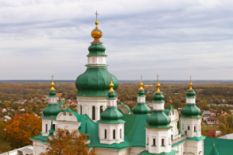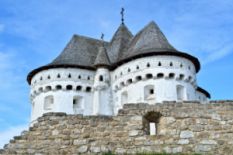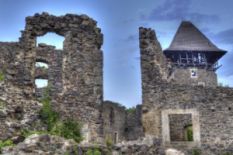Construction
 What is now a grand temple consisting of numerous churches, bell tower and archbishop's residence once hasn't been so luxurious. The first monastery premises were set in the caves and the first wooden building, Dormition Church, is said to have been built in the 13th century on the hill. Some legends state that Pochayivsky monastery was founded by the monks of Kyiv Perchersk Lavra that fled from the 1240 Mongol invasion.
What is now a grand temple consisting of numerous churches, bell tower and archbishop's residence once hasn't been so luxurious. The first monastery premises were set in the caves and the first wooden building, Dormition Church, is said to have been built in the 13th century on the hill. Some legends state that Pochayivsky monastery was founded by the monks of Kyiv Perchersk Lavra that fled from the 1240 Mongol invasion.
However, officially the church is first mentioned in 1527. During the second part of the 16th century, the monastery was flourishing thanks to Job of Pochayiv, who now bears a status of a saint. Throughout his lifetime, Job of Pochaiv established living premises for the monks, surrounded the monastery with a fence and established a printing house, which was quite popular in the era. In 1597, Pochayivsky monastery gained one of its most famous sacred elements - the icon of the Mother of God. The icon was granted to the monastery by Anna Hoiska, wife of the provincial judge who owned Pochaiv in the second part of the 16th century. While the exact origin of the icon is unknown, it is considered to be a gift from a Greek Metropolitan Neophyte to Anna Hoiska. The icon is written in the Byzantium style and depicts Mary, Jesus and numerous saints like Elijah, Saint Stephen and Saint Katherine.
Nowadays Pochaiv Icon of the Mother of God is one of the most sacred Orthodox icons. Pochayivska Lavra has also played a great part in the history of Ukraine - for instance, in 1651 the monastery monks gave shelter to the Cossack officers and nobleman Zavadsky after the July Battle of Berestechko. One of the legends also states that the Pochaiv Icon of the Mother of God saved the local dwellers from the Turk invasion in 1675. The event is reflected in 'Pochaiv Mother of God' duma - an epic poem immensely popular during the Hetmanate Era.
Going Catholic
In the second part of the 17th century, the territory of Western Ukraine became a platform of opposition of the Catholic and Orthodox churches. After the 1648—1657 Khmelnytsky Uprising which ended in a defeat for the Cossacks, the Polish government made extensive efforts to convert dwellers of Ukrainian lands and local temples to Catholicism. Pochayivsky monastery wasn't an exception. In 1713, the monastery was converted into a Greek Catholic temple. During this era, Pochayivsky temple gained its most luxurious part - Saint Dormition Church or Sviato-Uspenska Church.
The new Sviato-Uspenska Church became the central part of the monastery architectural composition. The interior is decorated with golden elements and the altar is adorned with numerous columns and statues in the classical Catholic style. The altar and interior of the Pochayivsko-Uspenska Lavra impressed not only the parish but also artists - the famous Ukrainian painter and writer Taras Shevchenko depicted the Lavra in 1846 in a series of sketches and watercolors.
Back to Orthodox
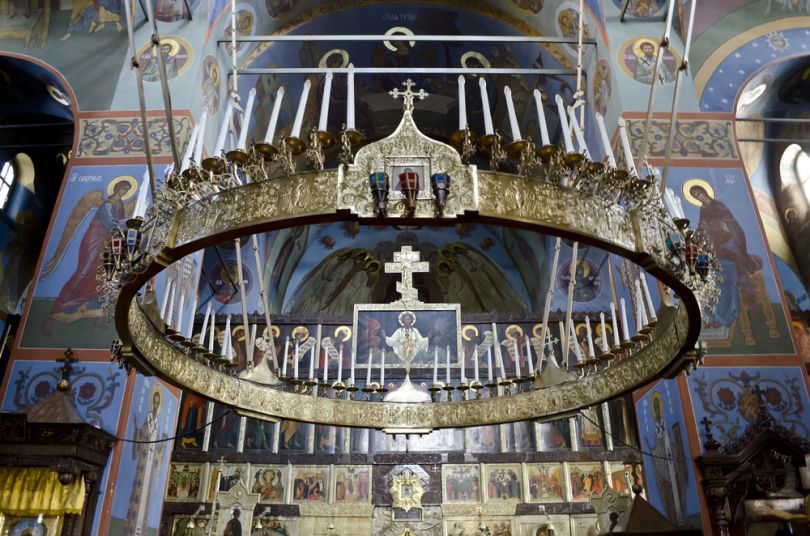 The political disposition in Eastern Europe has changed once again in the 19th century. In 1831, the Kingdom of Poland, Lithuania, Bilorus as well as Right-bank Ukraine was engaged in the November Uprising. Also known as the Polish–Russian War 1830–31, the uprising began in Warsaw led by the officers from the Army of the Congress Poland. The revolt was ultimately crushed by the Russian Empire forces and Poland declared a part of Russia. The predominant faith on the territory of Ukraine changed once more.
The political disposition in Eastern Europe has changed once again in the 19th century. In 1831, the Kingdom of Poland, Lithuania, Bilorus as well as Right-bank Ukraine was engaged in the November Uprising. Also known as the Polish–Russian War 1830–31, the uprising began in Warsaw led by the officers from the Army of the Congress Poland. The revolt was ultimately crushed by the Russian Empire forces and Poland declared a part of Russia. The predominant faith on the territory of Ukraine changed once more.
In November 1831 Pochayivsko-Uspenska Church was returned to the Orthodox branch. Two years later, the Ukrainian church gained the status of Lavra - the fourth of all monasteries on the territory of the Russian Empire. It's interesting that the printing house at Pochayivsko-Uspenska Lavra was used to spread literature of opposing views in different eras. In 1730-1831 the printing house issued 187 books on religion, while at the beginning of the 20th century it printed and distributed anti-Ukrainian literature mostly by the extremist right party Union of the Russian People.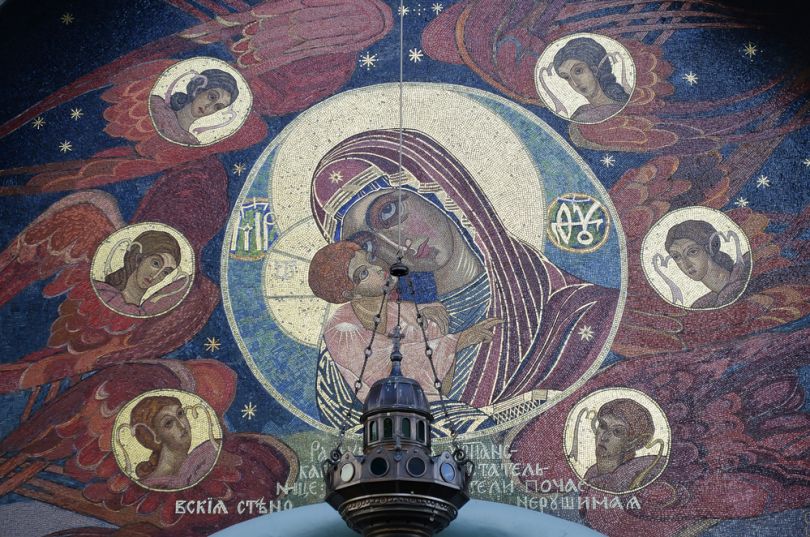 Like many Ukrainian temples, Pochayivsko-Uspenska Lavra was evacuated during the WWI - bells, archive documents and books from the library were transported to be saved from looting. As for the sacred church elements, the icon of the Mother of God and relics of Saint Job were transported to Zhytomyr, where they were kept until the end of the war. At the beginning of 1919, Lavra was looted by Bolsheviks who stole the remaining worthy relics. During the WWII Pochayivsko-Uspenska Lavra experienced a new wave of anti-religious campaigns. While the monastery wasn't ruined, archimandrite Alypius that served in the church at the time was imprisoned and died in captivity.
Like many Ukrainian temples, Pochayivsko-Uspenska Lavra was evacuated during the WWI - bells, archive documents and books from the library were transported to be saved from looting. As for the sacred church elements, the icon of the Mother of God and relics of Saint Job were transported to Zhytomyr, where they were kept until the end of the war. At the beginning of 1919, Lavra was looted by Bolsheviks who stole the remaining worthy relics. During the WWII Pochayivsko-Uspenska Lavra experienced a new wave of anti-religious campaigns. While the monastery wasn't ruined, archimandrite Alypius that served in the church at the time was imprisoned and died in captivity.
Lavra nowadays
 After the fall of the USSR, religious life and educational establishments at Pochayivsko-Uspenska Lavra were restored: pastoral courses were launched again in 1991 and the theological seminary was established in 1994. Until 2018, numerous buildings of Pochayivsko-Uspenska Lavra were illegally registered as property of the Ukrainian Orthodox Church under Moscow Patriarchate, as stated in the message of Ministry of Justice of Ukraine. The illegal registration was cancelled by the Ministry of Justice.
After the fall of the USSR, religious life and educational establishments at Pochayivsko-Uspenska Lavra were restored: pastoral courses were launched again in 1991 and the theological seminary was established in 1994. Until 2018, numerous buildings of Pochayivsko-Uspenska Lavra were illegally registered as property of the Ukrainian Orthodox Church under Moscow Patriarchate, as stated in the message of Ministry of Justice of Ukraine. The illegal registration was cancelled by the Ministry of Justice.
Nowadays Lavra is one of the most visited Orthodox temples in Western Ukraine. It is especially popular during the traditional religious holidays and the special days established by the religious community, for instance, August 28 marks the holiday of Dormition of the Mother of God and September 10 commemorates Saint Job of Pochayiv.
Photo sources: taras-shevchenko.com.ua, pochaev.org.ua, depositphotos.com. All images belong to their rightful authors.


